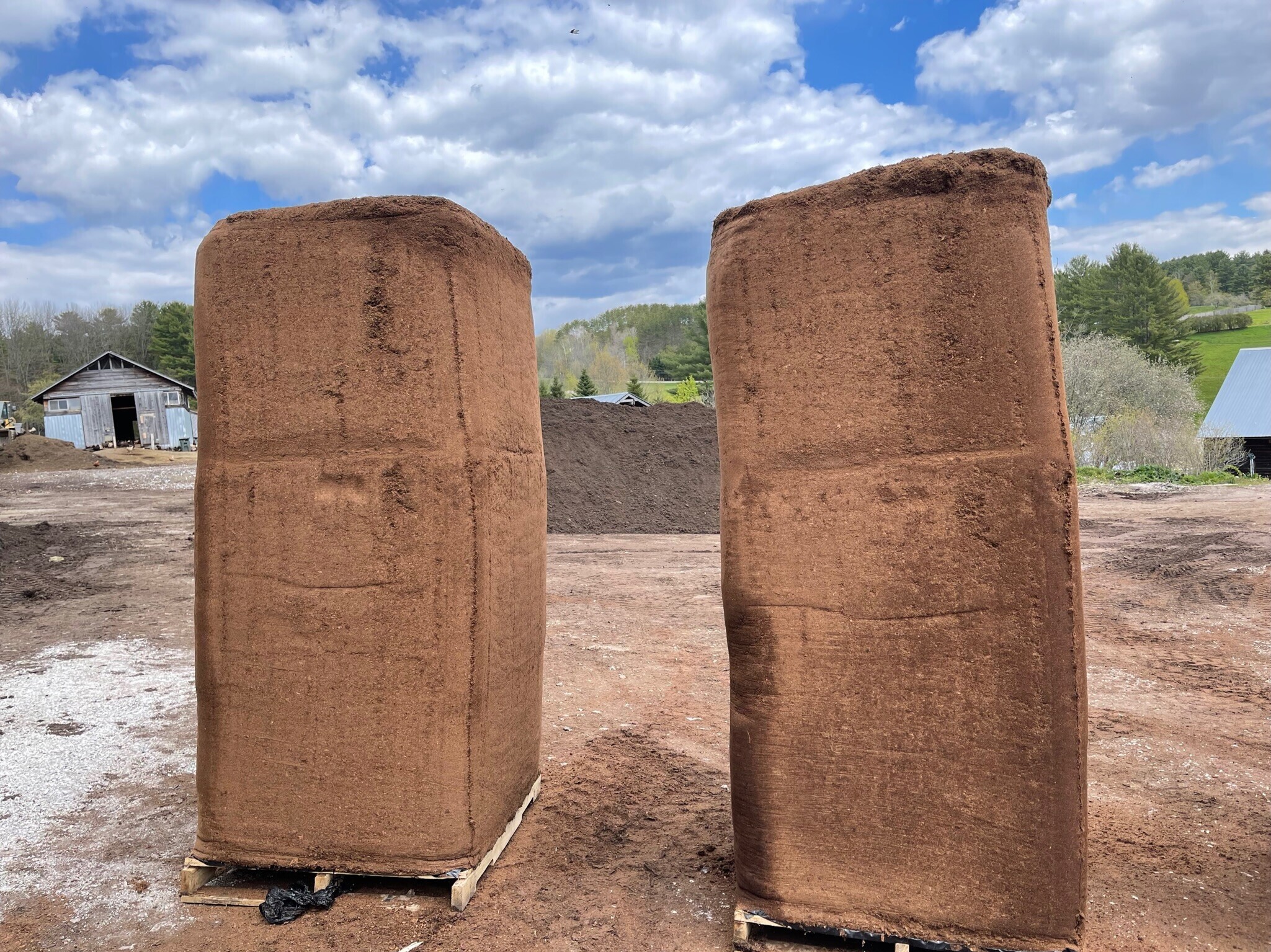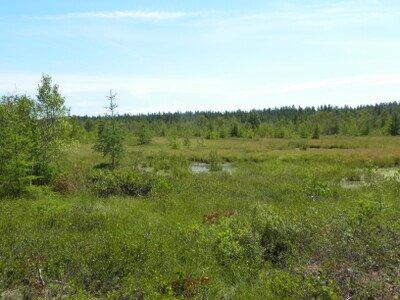
The Role of Peat Moss in our Potting Mixes
Mature compost is a soil amendment of inestimable value and the base of all our potting media blends. When properly applied to agricultural soils, compost replenishes humic complexes, macro- and micro-nutrients, and bacterial and fungal biota that make nutrients available to plants.
However, compost also has a high density as well as a high pH, making it largely unsuitable for stand-alone use as a germination or cultivation mix. Mature compost lacks the pore space needed to hold oxygen, a key determinant in the proliferation of plant-friendly aerobic microbes.
To meet these needs, we craft our soil blends with an appropriate proportion of peat moss, which adds loft and porosity to the mixes. Peat represents only about 20% of the mass of our soil blends, but its addition allows the media to easily transfer water and air, thereby promoting healthy microbial profiles and fostering robust root development. When processed for horticultural use, peat products are capable of holding 10-20 times their dry weight in water, as well as an incredible quantity of cations for later exchange with plant roots (1).
Peat Moss in its Natural Context
Peat mosses are the anaerobically digested organic residues of ombrotrophic vegetation, termed Histosols by soil scientists. These soils are distributed worldwide but comprise only about 3% of earth’s land area (2). Waterlogged and oxygen-starved, Histosols are bog soils.
Despite the limited acreage of Histosols relative to the world’s total land area, they are a major carbon sink, sequestering somewhere around 20% of earth’s total soil carbon (3). Any depletion of this resource, including harvesting for horticultural use, releases sequestered carbon and negatively impacts the climate. However, the amount of peat harvested each year for horticultural amendments is dwarfed by peat harvests for fuel and by bog clearing and draining for the creation of new agricultural lands (4).
Responsibly Sourcing Peat Moss

Our company was founded on the principle that agriculture could and should be conducted with soil health as its primary responsibility; hence our motto, ‘Feed the Soil.’ Continuing to honor this maxim is a priority for VCC, and as such, we source our ingredients as ethically as possible, and mitigate our carbon footprint wherever feasible.
Our sourcing strategy is split into two complementary processes: establishing and maintaining relationships with producers that meet our standards for appropriate particle size, while also vetting those producers for adherence to responsible peatland management practices (5).
Since many horticultural peat products are milled, they contain a higher proportion of fine particles than coarse. This is problematic in a container media, as the fines can occlude and block water and air infiltration, potentially restricting or even suffocating root growth. We source peat that contains a favorable ratio of coarse-to-fine particles, ensuring aeration and loft in our mixes.
In support of our founding principle, we also assess our peat suppliers for their environmental ethics. Many are members of the Canadian Sphagnum Peat Moss Association and signatories to its policy requisites, which include reclamation of harvested bog sites (7). Bogland reclamation includes either leaving a layer of ombrotrophic material in place during harvest or dispersing harvested vegetation over the area to reestablish plant growth. Then, the bog is mulched with wheat straw, reflooded to natural conditions, and monitored for successful plant community reestablishment. The above photo (© S.Boudreau), demonstrates a reclaimed bog.
Unlike harvesting, conversion of peatlands into farmable land represents a disproportionate and potentially permanent diminution of the total resource base. Our peat moss suppliers have a vested interest in the perpetuity of harvestable boglands, so their practices are not a zero-sum endeavor.
Responsibly Using Peat Moss
Once processed, peat moss continues to slowly release carbon as the peat oxidizes, but our potting media—in the hands of conscientious farmers—will spend only 3-7 months of its lifespan as a bulk pile or bagged product. Once seeds have germinated in one of our soil mixes, the soil becomes a carbon sink once again. This process intensifies when a plug is transplanted into the field, where it interacts with the native soil biota. The peat component is no longer open to oxidation, as it’s instead busy exchanging nutrients with the rhizosphere of the plants it holds; once again sequestering carbon and improving the tilth of the soil.
We understand that our planet’s biosphere faces unprecedented challenges, and that each and every person and business bears some responsibility for this state of crisis. However—as a business—we seek to practice something akin to ecological economics, and so we carefully balance our budgets with a moral obligation to promote sustainable agricultural practices.
Having soul-searched on this issue for many years, we’ve come to the conclusion that our use of peat moss is the necessary base that is ultimately transmuted into soil health gold by our growers.
Seeking Alternatives for the Future
Our search for a suitable alternative for peat moss began in the early nineties, but we have yet to find a material that meets our needs as a replacement. Candidates must have both appropriate physical properties and meet our ethical considerations.
Coconut coir, for instance, is often used as a media addition. However, our testing has shown that on its own, it does not suffice to lighten a compost-based mix while simultaneously buffering against an excessively high pH. While our mixes contain a portion of coir, it is inappropriate as a 1:1 peat moss substitute. In addition, coconut coir’s carbon footprint must be calculated as a function of the many thousands of miles it travels from tropical production sites to our latitude.
Until we have found reliable suppliers of a comparable product, we will continue to source peat consciously and use it judiciously. Because our growers are an intrinsic part of the lifecycle of the sphagnum that is reincarnated into our potting mixes, they deserve credit and gratitude for helping to cycle this valuable resource by implementing their best possible cultivation and tillage practices.
Sources
(1) A.C. Bunt, Media And Mixes For Container-Grown Plants: a manual on the preparation and use of growing media for pot plants, Second Edition, London, Unwin Hyman Ltd., 1988, pg. 6
(2) UK Centre For Ecology & Hydrology, ‘Peatlands factsheet’, pg. 1, https://www.ceh.ac.uk/sites/default/files/Peatland%20factsheet.pdf
(3) Nyle C. Brady & Ray R. Weil, The Nature And Properties of Soils, Fourteenth Edition, Pearson Education Inc., 2008, pg. 604
(4) World Energy Council, ‘World Energy Resources: Peat’, pg. 3, https://www.worldenergy.org/assets/images/imported/2013/10/WER_2013_6_Peat.pdf
(5) Canadian Sphagnum Peat Moss Association, ‘Preservation & Reclamation Policy’, https://tourbehorticole.com/wp-content/uploads/2020/11/CSPMA-PresRec-Policy.pdf
(6) François Quinty and Line Rochefort, ‘Peatland Restoration Guide’, Second Edition, Quebec, Canadian Sphagnum Peat Moss Association and New Brunswick Dept. of Natural Resources and Energy, 2003, https://tourbehorticole.com/wp-content/uploads/2015/07/Peatland_Restoration-e.pdf
(7) International Union for the Conservation of Nature, ‘IUCN Issues Brief: Peatlands and Climate Change’, November 2021, https://www.iucn.org/resources/issues-briefs/peatlands-and-climate-change
Restored peatland photo © S.Boudreau.
